Understanding Qualcomm's Snapdragon 810: Performance Preview
by Joshua Ho & Andrei Frumusanu on February 12, 2015 9:00 AM EST- Posted in
- SoCs
- Qualcomm
- Mobile
- Gobi
- Snapdragon 810
GPU Performance
Last but certainly not least, we have GPU performance. As we mentioned earlier, the Snapdragon 810 introduces Qualcomm's Adreno 430, the latest member of the Adreno 400 GPU family. Qualcomm's own performance estimates call for a 30% increase over Adreno 420, with a final GPU clock of 600MHz being identical to the Snapdragon 805's (Adreno 420) own GPU clock speed.
From an architectural standpoint Adreno continues to be something of a black box for us. Other than being a modern OpenGL ES 3.1/AEP design, we don't know too much about how the GPU is laid out, and Qualcomm's current legal battle with NVIDIA likely not helping matters. In any case, Qualcomm has indicated that Adreno 430 is not just a simple extension of Adreno 420, so we may be looking at an architectural change such as wider shader blocks.
For today's benchmarks, as we mentioned before we only had a limited amount of time with the Snapdragon 810 and had issues with BaseMark X. We've had to pare down our GPU benchmarks to just 3DMark 1.2 and GFXBench 3.0. Once we get final hardware in, we will be able to run a wider array of graphics benchmarks on Snapdragon 810.
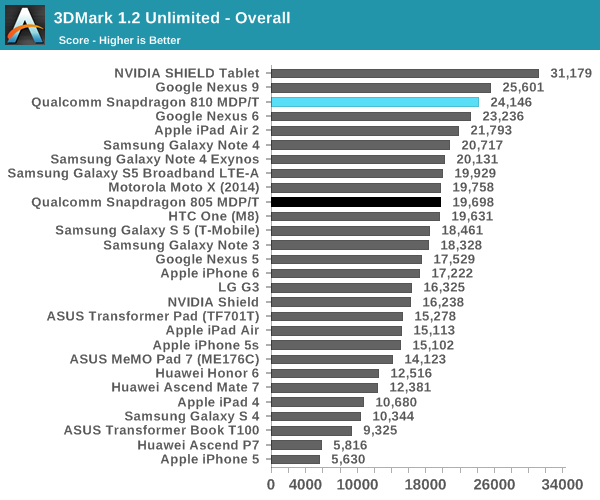
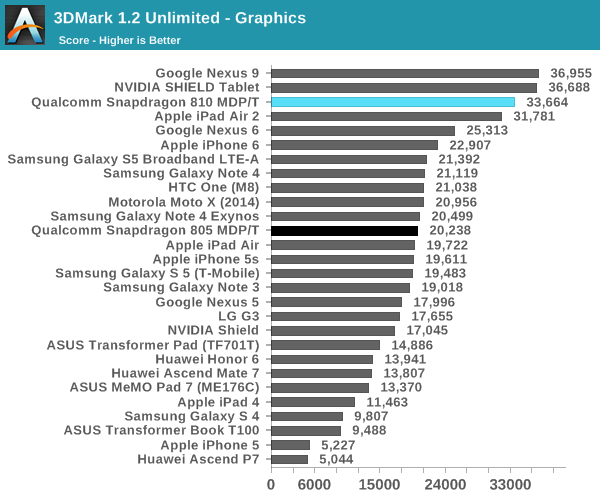
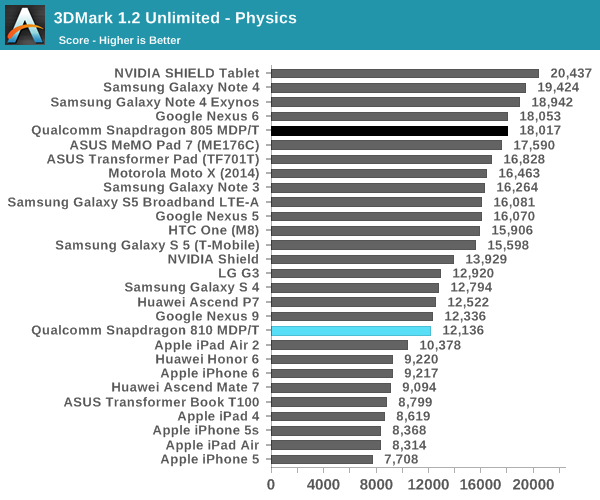
Starting off with 3DMark, compared to the Snapdragon 805 reference platform the actual graphics performance advantage is even greater than 30%, coming in at closer to 65%. However since drivers play a big role in this, a more recent 805 platform like the Nexus 6 may be a better comparison point, in which case the gains are 33%, just a hair over Qualcomm's own baseline performance estimate. We also find that Snapdragon 810 oddly struggles at physics performance here, underperforming Snapdragon 805 devices, something the Exynos 5433 didn't have trouble with. As a result overall performance is only slightly improved over the Nexus 6.
Continuing with GFXBench, we look at more pure GPU loads. One has to take note that the MDP/T employs a 4K screen resolution, and the on-screen results will likely suffer from that.

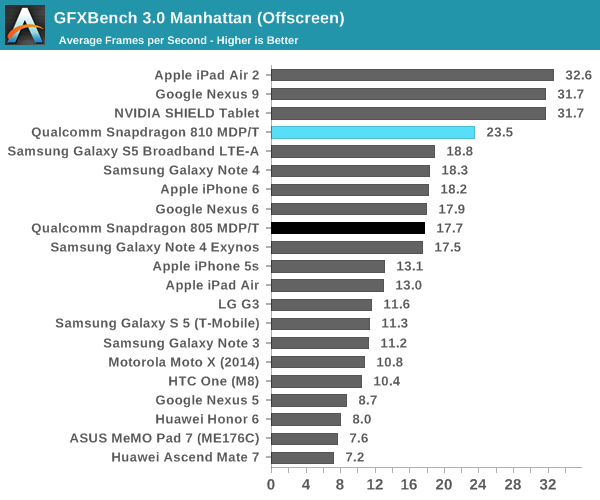
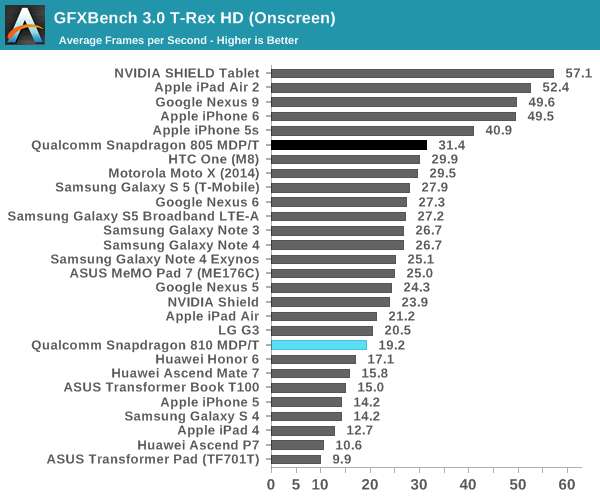
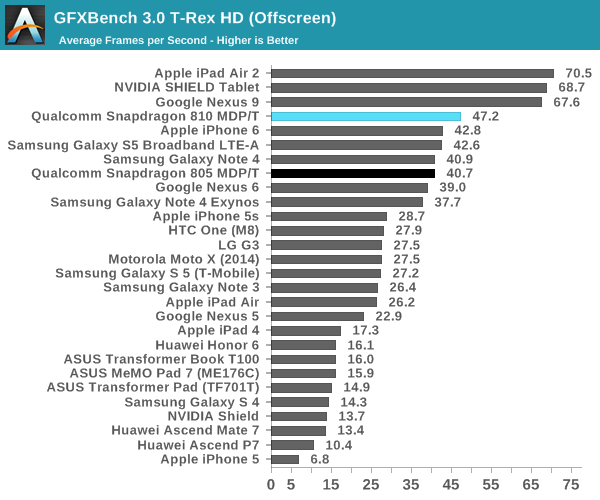
Under GFXBench 3.0's full rendering tests of Manhattan and T-Rex, the Snapdragon 810 continues to show considerable performance gains over the Snapdragon 805. Ignoring the onscreen results for now since the Snapdragon 810 reference platform runs at such a high resolution, offscreen results show the 810 outperforming the 805 by 33% in Manhattan and 16% in T-Rex. The former is again well in-line with Qualcomm's performance estimate, wile the older T-Rex benchmark doesn't show the same gains, possibly indicating that Adreno 430's biggest gains are going to come from shader-bound scenarios.
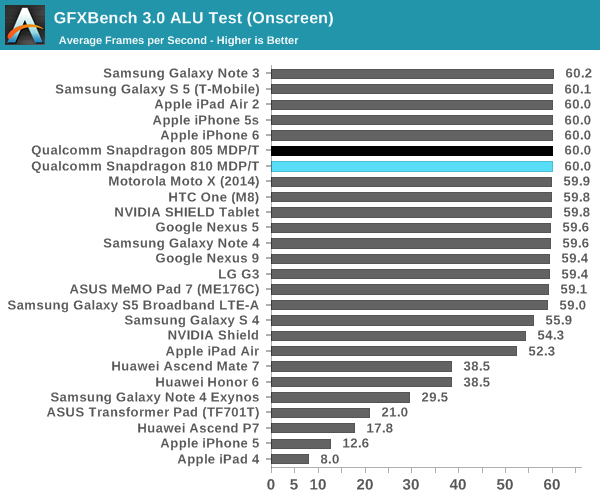
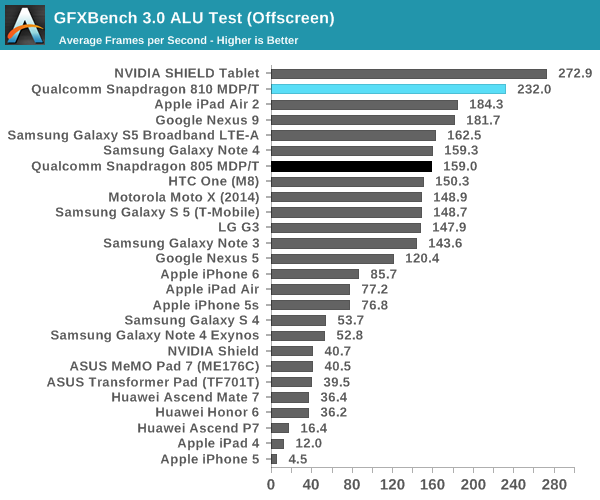

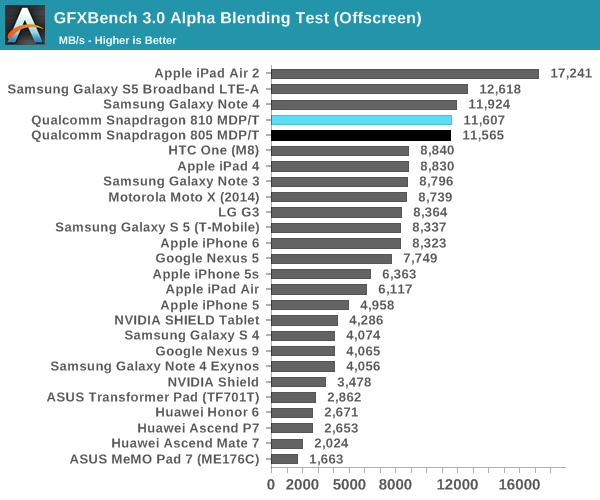
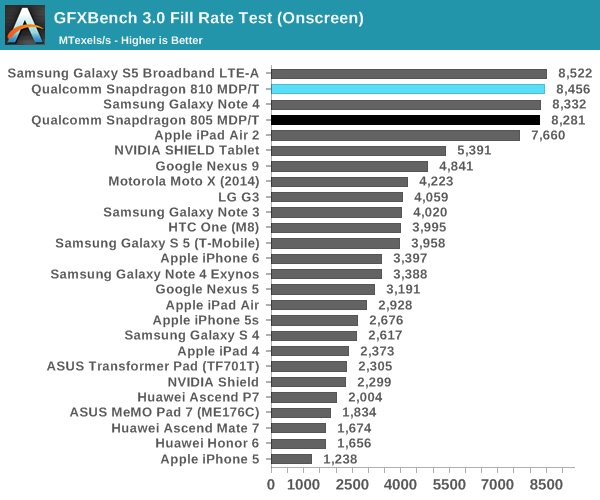
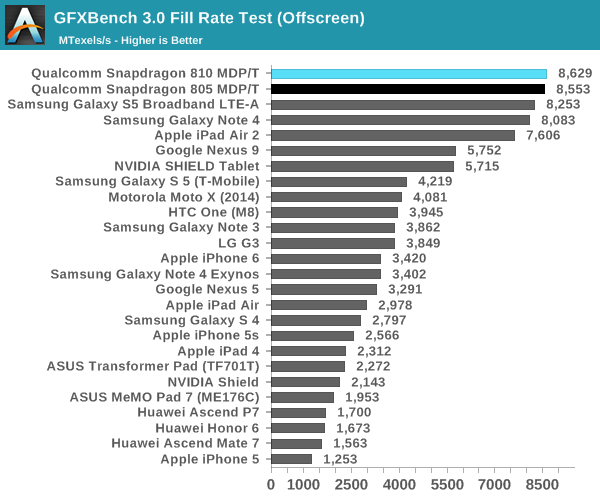
Meanwhile GFXBench's synthetic tests continue to put Adreno 430 and the Snapdragon 810 in a good light. ALU performance in particular is showing very large gains - 46% better than the Snapdragon 805 and Adreno 420 - while our blending and fillrate tests show almost no gain over Snapdragon 805. This adds further credence to our theory that Qualcomm has widened or otherwise improved Adreno's shader blocks for 430, as other elements of the GPU are not showing significant performance changes.
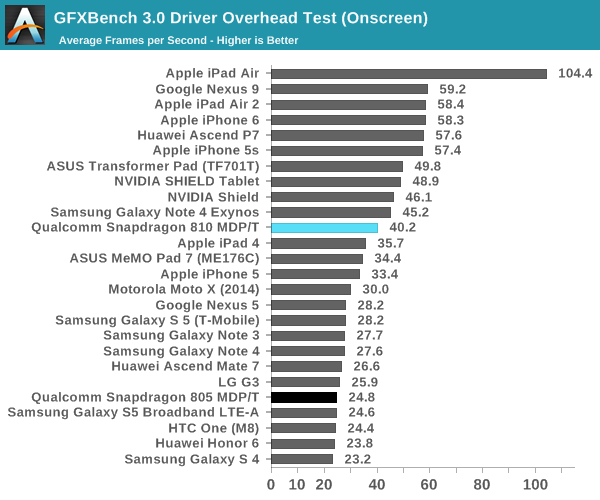
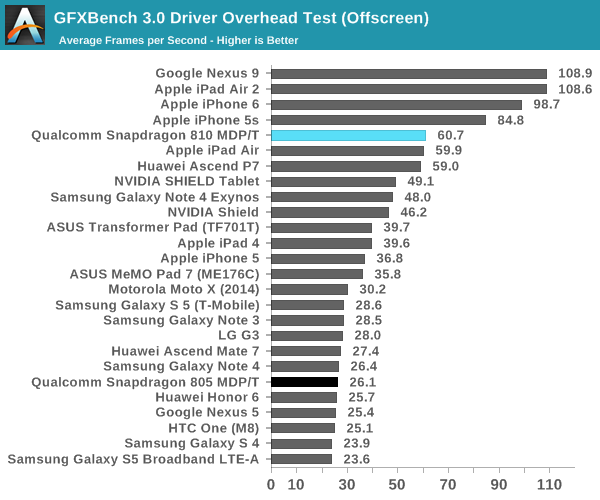
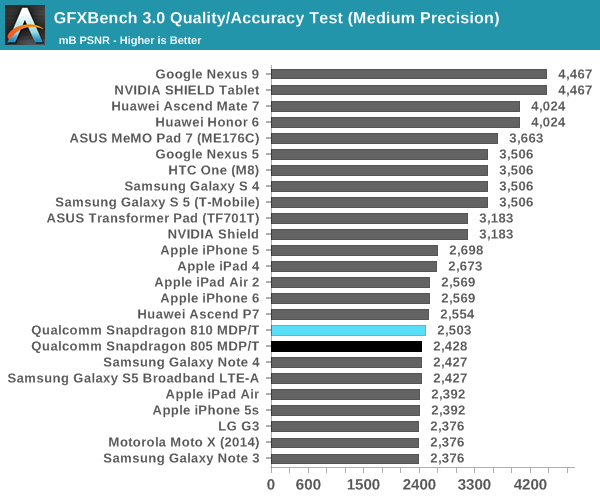

Finally, GFXBench's driver overhead and accuracy tests are more or less what we would expect for Snapdragon 810. In the case of driver overhead, a combination of newer drivers and a much faster CPU have reduced the CPU cost of driver overhead. Meanwhile with the underlying GPU architecture being unchanged, there are no material changes to quality/accuracy.
Overall then the performance gains for the Adreno 430 and Snapdragon 810 seem to be almost exclusively focused on shader performance, but in those cases where rendering workloads are shader bound, Qualcomm's 30% estimate is on the mark. Real-word performance gains meanwhile are going to depend on the nature of the workload; games and applications that are similarly shader-bound should see good performance gains, while anything that's bottlenecked by pixel throughput, texturing, or front-end performance will see much smaller gains. Thankfully for Qualcomm most high-end workloads are indeed shader bound, and this is especially the case when pushing high resolutions, as Qualcomm is trying to do with their 4K initiative for Snapdragon 810. However in the case of 4K, while Adreno 430 offers improved performance it's still slow enough that it's going to struggle to render any kind of decently complex content at that resolution.
As for Adreno 430 versus the competition, Qualcomm has narrowed much of the gap between themselves and NVIDIA/Apple, but they haven't closed it. Apple's Imagination GX6850 and NVIDIA's K1 GPUs continue to hold a performance advantage, particularly in GFXBench's Manhattan and T-Rex full rendering tests. Both Apple and NVIDIA invested significant die space in graphics, and while we don't know how much Qualcomm has invested in Adreno 430 with Snapdragon 810, it's safe to say right now that they would need to invest even more if they want to beat the graphics performance of NVIDIA and Apple's tablet SoCs.










119 Comments
View All Comments
Uplink10 - Friday, February 13, 2015 - link
That price is too high and is not intended for manufacturers, Bay Trail chips also have a high price but for the price of Bay Trail chip you get motherboard with Bay Trail chip. Also that chip is an overkill for a tablet, with that much features (vPro-remote bios...) it should be used as a server.metayoshi - Friday, February 13, 2015 - link
The price on that website IS for manufacturers:Recommended Customer Price (RCP) is pricing guidance only for Intel products. Prices are for direct Intel customers, typically represent 1,000-unit purchase quantities, and are subject to change without notice. Prices may vary for other package types and shipment quantities. Listing of RCP does not constitute a formal pricing offer from Intel.
Taneli - Thursday, February 12, 2015 - link
K1 is tablets only with no integrated modem and X1 is closer to 10w TDP so it needs active cooling. The Snapdragon here is a totally different chip. And Apple doesn't sell SOCsdragonsqrrl - Thursday, February 12, 2015 - link
Errr... what? 10W TDP? Link please?kron123456789 - Friday, February 13, 2015 - link
Well, Nvidia claimed that Tegra X1 consumes 10W while running The Elemental demo.jjj - Thursday, February 12, 2015 - link
Funny how you insist in comparing it to the 805 not the 5433 when commenting on the Geekbench results. That kind of behavior shows the desire to please the maker of the product not to inform the users, yet it is a persistent Anandtech problem.Might have missed it but you don't seem to even mention clocks either , the SD 810 is at 2GHz i assume and the Exynos is at 1.9GHz, 5% is plenty. Nothing on throttling ,nothing on power, you basically help them better their damaged image without having the complete data. That's unethical and you just accept being manipulated into it.
As for overheating ,we don't know what clocks they targeted and i haven't noticed any mention of what revision you are testing. For delays,there are already delays (that's not debatable) compared to their most optimistic previously disclosed timing.
Just showing the perf numbers we already knew,without looking beyond that doesn't really help.
A5 - Thursday, February 12, 2015 - link
I really doubt Qualcomm was going to let them take apart their reference tablet to get power numbers.That said, 2015 seems like a good "skip year" on the Android flagship front unless the Exynos 7420 is a real blockbuster. I don't really see anything in this article that supports the conclusion at the end.
TylerGrunter - Thursday, February 12, 2015 - link
I fully support you there. Snapdragon 810 seems to be competitive with Exynos 5433 and A8 chips, the sad news is that those are 6 month old and there are not the SoCs it will have to compete with.Exynos 7420 has been a beast in preliminary benchmarks, so I hope for that (or Intel coming with something) not to have what you are calling a "skip year".
And for tablets we'll always have Intel or NVidia.
JimRamK - Thursday, February 12, 2015 - link
What about Intel chips?A5 - Thursday, February 12, 2015 - link
AFAIK, they don't have any design wins in phones. I don't think 14nm is going to change that, but we'll see.